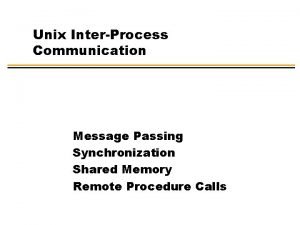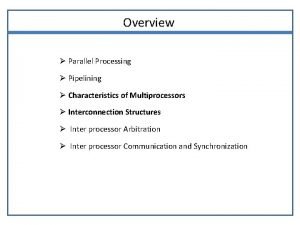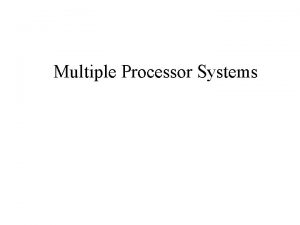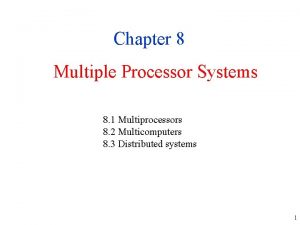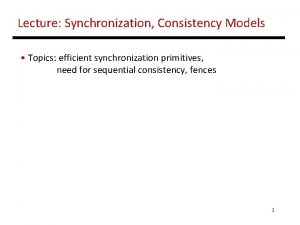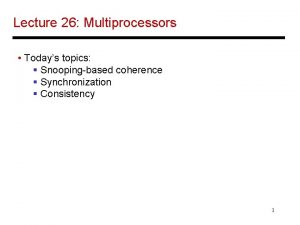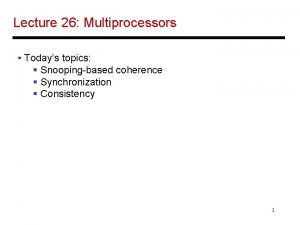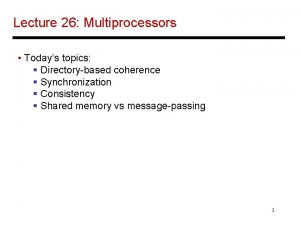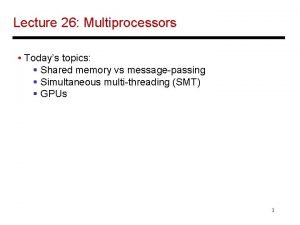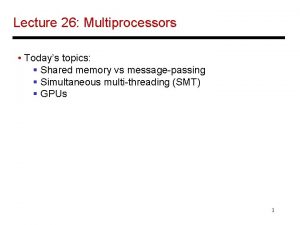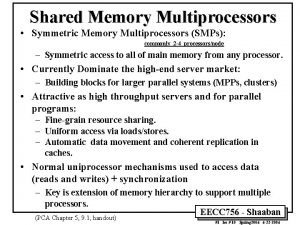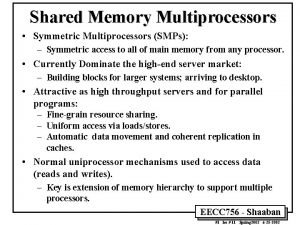Lecture 25 Multiprocessors Todays topics Synchronization Consistency Shared















- Slides: 15

Lecture 25: Multiprocessors • Today’s topics: § Synchronization § Consistency § Shared memory vs message-passing § Simultaneous multi-threading (SMT) 1

Constructing Locks • Applications have phases (consisting of many instructions) that must be executed atomically, without other parallel processes modifying the data • A lock surrounding the data/code ensures that only one program can be in a critical section at a time • The hardware must provide some basic primitives that allow us to construct locks with different properties Bank balance $1000 Rd $1000 Add $100 Wr $1100 Parallel (unlocked) banking transactions Rd $1000 Add $200 Wr $1200 2

Synchronization • The simplest hardware primitive that greatly facilitates synchronization implementations (locks, barriers, etc. ) is an atomic read-modify-write • Atomic exchange: swap contents of register and memory • Special case of atomic exchange: test & set: transfer memory location into register and write 1 into memory (if memory has 0, lock is free) • lock: t&s register, location bnz register, lock CS st location, #0 When multiple parallel threads execute this code, only one will be able to enter CS 3

Coherence Vs. Consistency • Recall that coherence guarantees (i) write propagation (a write will eventually be seen by other processors), and (ii) write serialization (all processors see writes to the same location in the same order) • The consistency model defines the ordering of writes and reads to different memory locations – the hardware guarantees a certain consistency model and the programmer attempts to write correct programs with those assumptions 4

Consistency Example • Consider a multiprocessor with bus-based snooping cache coherence Initially A = B = 0 P 1 P 2 A 1 B 1 … … if (B == 0) if (A == 0) Crit. Section 5

Consistency Example • Consider a multiprocessor with bus-based snooping cache coherence Initially A = B = 0 P 1 P 2 A 1 B 1 … … if (B == 0) if (A == 0) Crit. Section The programmer expected the above code to implement a lock – because of ooo, both processors can enter the critical section The consistency model lets the programmer know what assumptions 6 they can make about the hardware’s reordering capabilities

Sequential Consistency • A multiprocessor is sequentially consistent if the result of the execution is achieveable by maintaining program order within a processor and interleaving accesses by different processors in an arbitrary fashion • The multiprocessor in the previous example is not sequentially consistent • Can implement sequential consistency by requiring the following: program order, write serialization, everyone has seen an update before a value is read – very intuitive for the programmer, but extremely slow 7

Shared-Memory Vs. Message-Passing Shared-memory: • Well-understood programming model • Communication is implicit and hardware handles protection • Hardware-controlled caching Message-passing: • No cache coherence simpler hardware • Explicit communication easier for the programmer to restructure code • Software-controlled caching • Sender can initiate data transfer 8

Ocean Kernel Procedure Solve(A) begin diff = done = 0; while (!done) do diff = 0; for i 1 to n do for j 1 to n do temp = A[i, j]; A[i, j] 0. 2 * (A[i, j] + neighbors); diff += abs(A[i, j] – temp); end for if (diff < TOL) then done = 1; end while end procedure . Row 1 . Row k Row 2 k Row 3 k … 9

Shared Address Space Model int n, nprocs; float **A, diff; LOCKDEC(diff_lock); BARDEC(bar 1); main() begin read(n); read(nprocs); A G_MALLOC(); initialize (A); CREATE (nprocs, Solve, A); WAIT_FOR_END (nprocs); end main procedure Solve(A) int i, j, pid, done=0; float temp, mydiff=0; int mymin = 1 + (pid * n/procs); int mymax = mymin + n/nprocs -1; while (!done) do mydiff = 0; BARRIER(bar 1, nprocs); for i mymin to mymax for j 1 to n do … endfor LOCK(diff_lock); diff += mydiff; UNLOCK(diff_lock); BARRIER (bar 1, nprocs); if (diff < TOL) then done = 1; BARRIER (bar 1, nprocs); endwhile 10

Message Passing Model main() read(n); read(nprocs); CREATE (nprocs-1, Solve); Solve(); WAIT_FOR_END (nprocs-1); for i 1 to nn do for j 1 to n do … endfor if (pid != 0) SEND(mydiff, 1, 0, DIFF); RECEIVE(done, 1, 0, DONE); else for i 1 to nprocs-1 do RECEIVE(tempdiff, 1, *, DIFF); mydiff += tempdiff; endfor if (mydiff < TOL) done = 1; for i 1 to nprocs-1 do SEND(done, 1, I, DONE); endfor endif endwhile procedure Solve() int i, j, pid, nn = n/nprocs, done=0; float temp, tempdiff, mydiff = 0; my. A malloc(…) initialize(my. A); while (!done) do mydiff = 0; if (pid != 0) SEND(&my. A[1, 0], n, pid-1, ROW); if (pid != nprocs-1) SEND(&my. A[nn, 0], n, pid+1, ROW); if (pid != 0) RECEIVE(&my. A[0, 0], n, pid-1, ROW); if (pid != nprocs-1) RECEIVE(&my. A[nn+1, 0], n, pid+1, ROW); 11

Multithreading Within a Processor • Until now, we have executed multiple threads of an application on different processors – can multiple threads execute concurrently on the same processor? • Why is this desireable? Ø inexpensive – one CPU, no external interconnects Ø no remote or coherence misses (more capacity misses) • Why does this make sense? Ø most processors can’t find enough work – peak IPC is 6, average IPC is 1. 5! Ø threads can share resources we can increase threads without a corresponding linear increase in area 12

How are Resources Shared? Each box represents an issue slot for a functional unit. Peak thruput is 4 IPC. Thread 1 Thread 2 Thread 3 Cycles Thread 4 Idle Superscalar Fine-Grained Multithreading Simultaneous Multithreading • Superscalar processor has high under-utilization – not enough work every cycle, especially when there is a cache miss • Fine-grained multithreading can only issue instructions from a single thread in a cycle – can not find max work every cycle, but cache misses can be tolerated • Simultaneous multithreading can issue instructions from any thread every cycle – has the highest probability of finding work for every issue slot 13

Performance Implications of SMT • Single thread performance is likely to go down (caches, branch predictors, registers, etc. are shared) – this effect can be mitigated by trying to prioritize one thread • With eight threads in a processor with many resources, SMT yields throughput improvements of roughly 2 -4 14

Title • Bullet 15
 Shared memory in unix
Shared memory in unix Acid vs base
Acid vs base Shared memory consistency models a tutorial
Shared memory consistency models a tutorial Characteristics of vector processing
Characteristics of vector processing Uma multiprocessors using multistage switching networks
Uma multiprocessors using multistage switching networks Multiple processor systems
Multiple processor systems Characteristics of multiprocessing
Characteristics of multiprocessing 01:640:244 lecture notes - lecture 15: plat, idah, farad
01:640:244 lecture notes - lecture 15: plat, idah, farad Todays jeopardy
Todays jeopardy Todays worldld
Todays worldld Date frui
Date frui Today's objective
Today's objective Todays plan
Todays plan Todays concept
Todays concept Todays science
Todays science Todays goal
Todays goal
